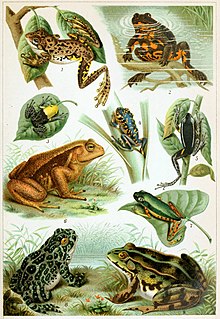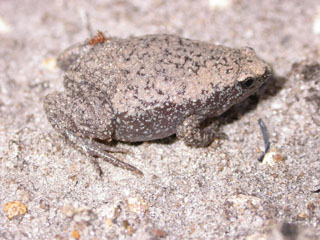
The eastern lesser bamboo lemur, also known as the gray bamboo lemur, the gray gentle lemur, and the Mahajanga lemur is a small lemur endemic to Madagascar, with three known subspecies. As its name suggests, the eastern lesser bamboo lemur feeds mainly on bamboo. The lemurs of the genus Hapalemur have more manual dexterity and hand–eye coordination than most lemurs. They are vertical climbers and jump from stalk to stalk in thick bamboo forests.

The bamboo warbler or bamboo scrub-warbler is a species of Old World warbler in the family Locustellidae.
It is found in Democratic Republic of the Congo, Ethiopia, South Sudan, Tanzania, Uganda, and Zambia.
Its natural habitats are subtropical or tropical moist montane forests and subtropical or tropical moist shrubland.
Werneria bambutensis is a species of toad in the family Bufonidae. It is endemic to western Cameroon where it occurs at high altitudes between Mount Manengouba and Mount Oku, including the eponymous Bamboutos Mountains. Its natural habitats are fast-flowing streams at elevations of 1,750–2,600 m (5,740–8,530 ft) above sea level, typically within montane forest patches. Outside the breeding season, it also seems to disperse away from streams into forest patches, open bamboo glades, and montane grassland. It is a rare species that is probably threatened by habitat loss.
Afrixalus orophilus is a species of frog in the family Hyperoliidae. It is found in Kivu in the eastern Democratic Republic of the Congo, Burundi, Rwanda, and southwestern Uganda. Common names Kivu banana frog, montane spiny reed frog, and two-lined leaf-gluing frog has been coined for it.
Platypelis alticola is a species of frog in the family Microhylidae.
It is endemic to Madagascar.
Its natural habitat is subtropical or tropical moist montane forests.
It is threatened by habitat loss.

Platypelis barbouri is a species of frog in the family Microhylidae.
It is endemic to Madagascar.
Its natural habitats are subtropical or tropical moist lowland forests, subtropical or tropical moist montane forests, and heavily degraded former forest.
It is threatened by habitat loss.
Platypelis cowanii is a species of frog in the family Microhylidae.
It is endemic to Madagascar.
Its natural habitat is subtropical or tropical moist montane forests.
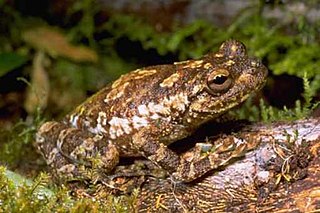
Platypelis grandis is a species of frog in the family Microhylidae.
It is endemic to Madagascar.
Its natural habitats are subtropical or tropical moist lowland forests and subtropical or tropical moist montane forests.
It is threatened by habitat loss. Juveniles are recognizable by the green protuberances on their body, which help them camouflage and hunt. When mature, coloring is brown and green. Insects make up the bulk of their diet.
Platypelis milloti is a species of frog in the family Microhylidae.
It is endemic to Madagascar.
Its natural habitat is subtropical or tropical moist lowland forests.
It is threatened by habitat loss.

Platypelis tetra is a species of frog in the family Microhylidae.
It is endemic to Madagascar.
Its natural habitats are subtropical or tropical moist lowland forests, subtropical or tropical moist montane forests, and heavily degraded former forest.
It is threatened by habitat loss.

Platypelis tuberifera is a species of frog in the family Microhylidae.
It is endemic to Madagascar.
Its natural habitats are subtropical or tropical moist lowland forests, subtropical or tropical moist montane forests, and heavily degraded former forest.
It is threatened by habitat loss.
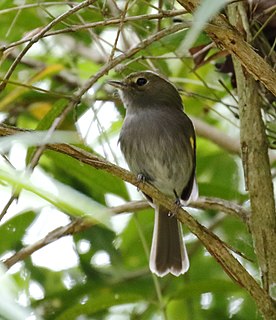
The drab-breasted bamboo tyrant is a species of bird in the family Tyrannidae.
It is found in Argentina, Brazil, and Paraguay.
Its natural habitats are subtropical or tropical moist lowland forest and subtropical or tropical moist montane forest.

The brown-breasted bamboo tyrant is a species of bird in the family Tyrannidae.
It is found in Argentina and Brazil.
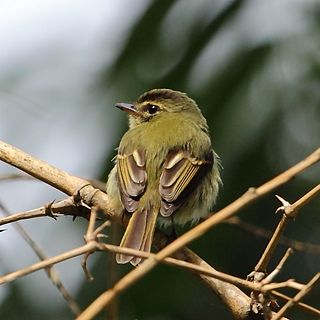
The large-headed flatbill, also known as the bamboo flatbill, is a species of bird in the family Tyrannidae.
It is found in Argentina, Bolivia, Brazil, Colombia, Ecuador, Paraguay, Peru, and Venezuela.
Its natural habitats are subtropical or tropical moist lowland forests and subtropical or tropical moist montane forests.
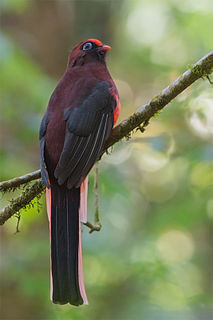
The Ward's trogon is a species of bird in the family Trogonidae. Its range includes the northeastern parts of the Indian subcontinent stretching eastwards to Southeast Asia. It is found in Bhutan, India, Tibet, and Myanmar. It also has a disjunct population in northern Vietnam, but there are no recent records from there. Its natural habitats are temperate forests and subtropical or tropical moist lowland forests. It is threatened by habitat loss.
The montane bamboo rat or Peruvian bamboo rat, is a species of rodent in the family Echimyidae. It is found in Bolivia and Peru. Its natural habitat is subtropical or tropical moist lowland forests.

The African giant shrew is a species of shrew. It is also known as Olivier's shrew. It is native to Africa, where it is widespread and occurs in many types of habitat. It is found near human habitation, where it is considered to be a pest species. Its natural habitats are subtropical or tropical dry forest, subtropical or tropical moist lowland forest, subtropical or tropical moist montane forest, dry savanna, moist savanna, arable land, rural gardens, urban areas, and heavily degraded former forest.

The Ugandan lowland shrew is a species of mammal in the family Soricidae. It is found in Kenya and Uganda. Its natural habitats are subtropical or tropical swamps and subtropical or tropical moist montane forest. It is threatened by habitat loss.

Babault's mouse shrew is a species of mammal in the family Soricidae found in Burundi, the Democratic Republic of the Congo, and Uganda. Its natural habitat is subtropical or tropical moist montane forests. It is threatened by habitat loss.
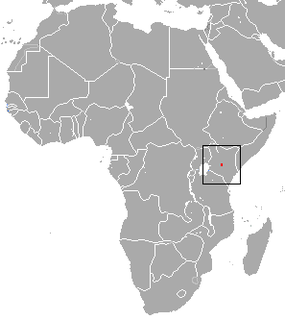
The Mount Kenya mole shrew is a species of mammal in the family Soricidae endemic to Mount Kenya in Kenya. Its natural habitat is tropical high-altitude bamboo and grassland.

